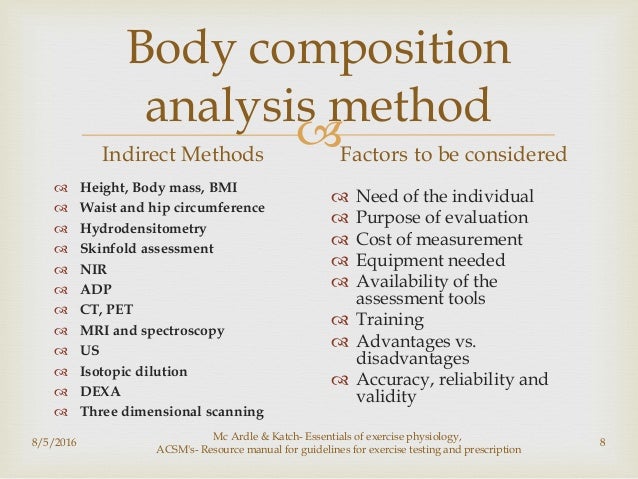
Contemporary Methods Of Body Composition Measurement
Weight is an overall measure of your body mass. Measuring body composition article literature review pdf available in archives of disease in childhood 917612 7 august 2006 with 3745 reads how we measure reads. More complex methods include bioelectrical impedance dual energy x ray absorptiometry body density and total body water estimates. This review is focused on currently applied methods for in vivo measurement of body composition including densitometry bioimpedance analysis dualenergy xray absorptiometry computed tomography ct. Ongoing efforts involve multisegmental and multifrequency bioelectrical impedance analysis quantitative magnetic resonance for total body water fat and lean tissue measurements imaging to further define ectopic fat depots. Reliable and valid body composition assessment is important in both clinical and research settings.
Dxa anthropometry waist circumference based model. On currently applied methods for in vivo measurement of body composition including densitometry bioimpedance analysis dual energy x ray absorptiometry computed tomography ct magnetic resonance techniques and anthropometry. Body composition measurement methods are continuously being perfected. A quick google search will reveal a number of different ways to measure body mass and composition. Body composition variables were measured by the following techniques. This review is focused on currently applied methods for in vivo measurement of body composition including densitometry bioimpedance analysis dual energy x ray absorptiometry computed tomography.
This review is focused on currently applied methods for in vivo measurement of body composition including densitometry bioimpedance analysis dual. Antrform bia using tanita tbf 310 and omron bf300 and a reference four compartment model. A multitude of methods and techniques for body composition measurement exist all with inherent problems whether in measurement methodology or in the assumptions upon which they are based. Contemporary methods of body composition measurement. Reliable and valid body composition assessment is important in both clinical and research settings. At any rate these 9 indicators are some of the most important factors to consider.
This measurement includes all of the elements of your body bones blood organs muscles and fat. This review is focused on currently applied methods for in vivo measurement of body composition including densitometry bioimpedance analysis dual energy x ray absorptiometry computed tomography ct magnetic resonance techniques and anthropometry. The most common assessments are anthropometric and include weight stature abdominal circumference and skinfold measurements. A multitude of methods and techniques for body composition measurement exist all with inherent problems whether in measurement methodology or in the assumptions upon which they are based. Body weight decreased significantly 33 sd 31 kg across the intervention.
Random Post
- giant gonzalez body measurements
- what is the perfect body measurement for a girl
- men's body measurement
- saima khan body measurement
- atif aslam body measurement
- willow hand body measurement
- bust measurement wear bra
- body measurements slimming world
- usha bachani body measurements
- iphone body measurement app
- sudeep body measurement
- best body fat measurement
- convert bra size to bust measurement
- arica sky body measurements
- increase body measurement
- noorin shereef body measurement
- baby body measurement chart
- how do you take a bra measurement
- best male body figure measurements
- general body measurements
- body measurement button
- pietro boselli body measurement
- body measurements of kpop idols
- shilpa shetty body measurement
- the body weight measurements
- effect of water on body fat measurement
- army body fat measurement standards
- carrie keagan body measurement
- human body temperature measurement gun
- thakur anoop singh body measurement
- leslie mann body measurement
- how to take your own bra measurement
- samantha body measurements
- air force body composition measurement
- riteish deshmukh body measurement
- website where you put in body measurements
- louise delos reyes body measurement
- introduction of body measurements
- shahrukh khan body measurement
- body measurement terms
- ancient system of measurement using body parts
- all bollywood actor body measurement
- bra measurement chart inches
- manjusha rampalli body measurement
- free body measurement tracker
- mouse body temperature measurement
- bra measurement m&s
- body measurements requirements for models
- body measurement mnemonic
- body fat percentage measurement methods


































